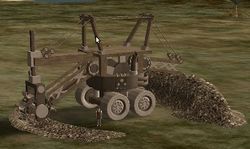Steam Shovel
| Steam Shovel | ||||||||||||||||||||||||||||||||
|---|---|---|---|---|---|---|---|---|---|---|---|---|---|---|---|---|---|---|---|---|---|---|---|---|---|---|---|---|---|---|---|---|
 |
||||||||||||||||||||||||||||||||
| (Building) | ||||||||||||||||||||||||||||||||
| Location | ||||||||||||||||||||||||||||||||
| Small Construction Site | ||||||||||||||||||||||||||||||||
| Requirements | ||||||||||||||||||||||||||||||||
|
||||||||||||||||||||||||||||||||
A Steam Shovel is a large building for automated harvesting of Dirt, Cuttable Stones, and Medium Stones.
Steam shovels must be located on Dirt, and must be built at least 500 feet (32 coords minimum) away from any other Steam Shovel so as to not interfere with each other (similar to Water Mines).
Steam Shovels are unique among all buildings in that Tuning them using Mechanics is not generally considered beneficial, and may be harmful, as explained below. Exercise caution in tuning non-Public Steam Shovels.
Use
Steam shovels are fueled by Petroleum. The produce Dirt, Cuttable Stones, and Medium Stones while running. Fuel can be added at any time, but items may not be removed from the Steam Shovel while it is running.
Steam shovels can be tuned with the Mechanics skill and/or Gear Oil, and accept a Springbox. One deben of Lubricating Oil will tune it to level 6.
Fuel
|
The rate of Petroleum consumption appears to depend on the level of tuning; fuel is consumed faster (and goods are produced faster) with higher tuning. Based on current data, the formula appears to be (240 / (16 - Tuning)) Petroleum consumed per Teppy-hour. Maximum fuel capacity is 350. For an untuned Steam Shovel, this will last just over one realtime day. More fuel can be added while the Steam Shovel is running. |
Output
There is a short (<1 hour) period of low production (but regular fuel consumption) right after starting the Steam Shovel, after which it settles into its normal rate. On average, a basic Steam Shovel will produce 1 Dirt, 1/2 Cuttable Stone, and 1/7 Medium Stones per Petroleum consumed.
The shovel becomes more efficient the longer it runs. After 6 days, it goes to 2x and increases another level every 3 days. After 21 days, it maxes out at 7x per petroleum consumed. Notably, this is directly a factor of run-time, and not simply from the steam shovel having produced a given amount of stones (or consumed a given amount of fuel) in a single run.
At each increase in efficiency, the Steam Shovel displays a new message when you examine the mechanism
- The machine wobbles and shakes as the gears are meshing, but seems to be working (initial 6-day run).
- Something has slipped in the mechanism, but it seems to be improving (first efficiency increase)
- The mechanism is running smoothly and increasing in temp (second increase)
Tuning does not affect the efficiency (Stones per Petroleum) of the Steam Shovel, but adding a Springbox does. This means that a well-tuned Steam Shovel will go through fuel more quickly than an un-Tuned Steam Shovel - the difficulty with Steam Shovels often being keeping them fed often enough to get to the higher efficiency tiers, as it takes days of uninterrupted run-time.
This means that, counter-intuitively, Tuning a Steam Shovel may be more of a hindrance than a help. However, if the Steam Shovel is prone to intentionally being stopped before it could get to the higher efficiency tiers, or you could not reliably expect to keep it fed that long to begin with as is likely the case with all Public Steam Shovels, then tuning may be desirable as it will increase the amount of stones produced in a given shorter amount of time, and there is no real chance of the shovel reaching the higher efficiency tiers to begin with.
Pollution
"The steam shovel belches forth a cloud of acrid smoke and rumbles to life. As it starts to run it seems to develop a rhythm the more it turns."
This message received after starting the Steam Shovel and implies that there may be pollution caused. More research is needed.
Please Create (was: See Also)